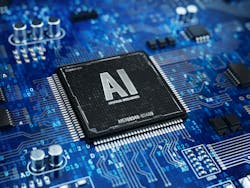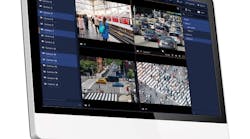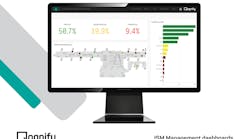Seamless integration of analytics with video camera controls, software drives AI
One of the most trending topics discussed across virtually every level of application in the physical security industry is Artificial Intelligence (AI), which is also often referred to as Machine Intelligence. According to Wikipedia, AI is applied when a machine mimics cognitive functions that humans associate with other human minds, such as learning and problem-solving.
The truth of the matter is that the AI moniker is most often misapplied or is being attributed prematurely to describe product and software solutions that are in fact intelligent but are just paving the pathway for solutions that will eventually learn and solve problems. As an industry, we are getting there with new software developments that deliver powerful processing capabilities, but we’ve got a way to go.
One of the specific areas of software development that continue to drive the AI movement in the physical security market is intelligent surveillance analytics. In retrospect, it’s safe to say that the development and deployment of intelligent analytics initially stimulated what has now become a paradigm shift in end-users’ perceptions of what video surveillance systems can and should do.
Whereas video surveillance was once relegated to real-time surveillance and forensic investigations, predictive analysis and prevention are now high on end-users’ list of expectations. This mindset has changed everything, and greatly influenced the development of new software and hardware solutions over the past few years. And, it has also further incentivized product and software engineers to accelerate their development processes and cycles.
Overall, surveillance software and hardware suppliers have responded relatively well by developing new analytics-based surveillance solutions based on end-users’ specific pain points. Much of this input is being culled from better interaction with end-users in the field, where needs drive technology. New sources of threats, liabilities, compliance mandates and the general desire to enhance overall protection of people, property and assets are the big influencers behind this shift in mindset and more aggressive product development strategies.
Many advanced and intelligent analytics are currently available and increasingly finding their way into more and more installations. Let’s take a closer look at how some of these surveillance analytics are being implemented and driving us closer to systems with real AI.
Intelligent Surveillance Analytics Solutions Driving AI
When we look at the evolution of surveillance specific analytics, one of the first and most impactful applications deals with motion detection. Initially, as with most new technologies, there were problems with simple tasks like multiple objects moving within the same frame, cameras’ inability to capture images with enough data to process object movement, and more. But those issues quickly dissipated as deficiencies were unearthed and addressed and improved surveillance cameras with higher resolution and faster frame rates made their way to market. Now widely considered a core or root system technology, motion detection is almost a given in the deployment of new system installs today.
With the advent of high-resolution megapixel cameras capable of operating in challenging lighting conditions, License Plate Recognition (LPR) has continued to grow in popularity -- not just with law enforcement agencies but across private industries for general security purposes, as well as for business intelligence applications such as fleet tracking and management, deliveries, personnel, and more. Today’s LPR analytics provide users with several unprecedented advantages, including the ability to accurately capture license plate information at very high speeds – up to 155 mph (250 km/h) if necessary. This and other new features are made possible by employing advanced deep learning and template-based algorithms to provide pinpoint accuracy under previously unmanageable conditions.
Perhaps the second most applied and sought-after intelligent surveillance analytic is facial recognition, which was also introduced several years ago with less than satisfactory results. Initially, recognition functionality suffered from a combination of inadequate video data and insufficient processing capabilities. However, facial recognition has evolved by leaps and bounds over recent years with the ability to scan multiple faces simultaneously, and the ability to match them almost instantly to various internal and external databases and watch lists. We can only expect facial recognition analytics to further improve as the technology continues to be implemented in more advanced integrated surveillance and access systems, as well as mainstream consumer products such as cell phones. Facial recognition technology also has numerous business intelligence applications such as identifying high rollers as they enter a casino, general time and attendance record keeping, and for account verification in the financial sector.
The same principles used to identify individuals with facial recognition are similarly being applied to cargo containers but with the extension of traditional LPR technologies. New cargo container analytics read ISO codes while providing a visual record of a container’s physical condition. This new analytics application is beneficial both to maritime and homeland security, but also in terms of providing additional logistics data.
Advanced analytics are also increasingly being bundled together and packaged as situational awareness analytics, providing users with a cost-effective means of enhancing their surveillance system’s capabilities with intelligent software versus additional hardware. The bundles include several specialized analytics such as loitering and crowd detection, object left behind and object counting, which can be used for a multitude of general surveillance applications such as monitoring schoolyards or retail parking areas after hours, as well as for business intelligence applications such as classifying vehicles, people and even animals. The versatility of these situational awareness analytics packages opens countless application possibilities.
In addition to centrally applied surveillance analytics integrated with a Video Management System (VMS), there are several products with embedded analytics available today. These products are designed for specialized applications within the context of a larger surveillance system, providing users with an attractive entry point to deploy analytics. Some examples include: mobile cameras designed for under-vehicle inspection at venues such as hotels, airports and government installations; cameras with speed detection and LPR to automatically detect and ticket violators; cameras with embedded Automatic Number Plate Recognition (ANPR) for automatically reading vehicle number plates to help detect, deter and disrupt criminal and terrorist activity; and cameras with analytics designed to recognize traffic violations. All these devices can be integrated into a centrally controlled surveillance solution without the need for a centralized analytics solution.
However, the time, effort and costs associated with the deployment of intelligent analytics have tended to slow market penetration. This is because many surveillance analytics available today usually come from various sources, requiring them to be integrated with some form of control platform capable of accommodating analytics rather than offering analytics as a native solution.
The physical security industry is clearly witnessing an evolutionary shift from hardware to software-based solutions with higher levels of intelligence. As we continue to develop platforms capable of layering native analytics and integration with enterprise level systems and big data, we will ultimately achieve AI with systems capable of learning and problem-solving. And until that day arrives, let’s avoid being accused of being “artificially intelligent” by claiming to offer something that’s undoubtedly coming soon…but not here just yet.
About the Author:
Aluisio Figueiredo is the CEO of Intelligent Security Systems (ISS).





